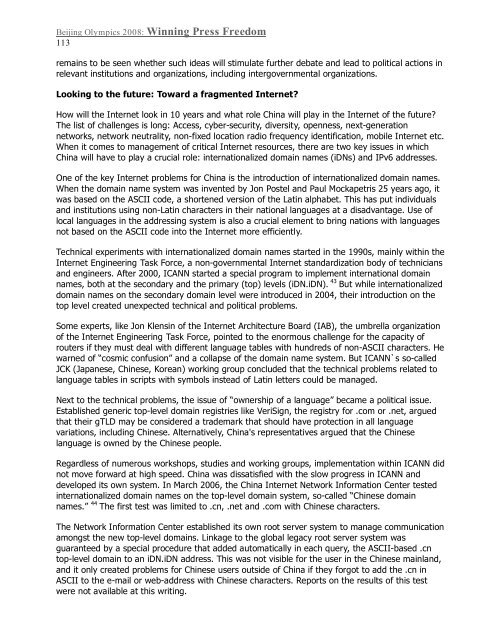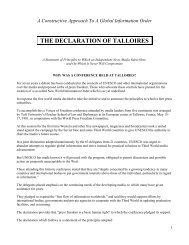Beijing Olympics 2008: Winning Press Freedom - World Press ...
Beijing Olympics 2008: Winning Press Freedom - World Press ...
Beijing Olympics 2008: Winning Press Freedom - World Press ...
Create successful ePaper yourself
Turn your PDF publications into a flip-book with our unique Google optimized e-Paper software.
<strong>Beijing</strong> <strong>Olympics</strong> <strong>2008</strong>: <strong>Winning</strong> <strong>Press</strong> <strong>Freedom</strong><br />
113<br />
remains to be seen whether such ideas will stimulate further debate and lead to political actions in<br />
relevant institutions and organizations, including intergovernmental organizations.<br />
Looking to the future: Toward a fragmented Internet?<br />
How will the Internet look in 10 years and what role China will play in the Internet of the future?<br />
The list of challenges is long: Access, cyber-security, diversity, openness, next-generation<br />
networks, network neutrality, non-fixed location radio frequency identification, mobile Internet etc.<br />
When it comes to management of critical Internet resources, there are two key issues in which<br />
China will have to play a crucial role: internationalized domain names (iDNs) and IPv6 addresses.<br />
One of the key Internet problems for China is the introduction of internationalized domain names.<br />
When the domain name system was invented by Jon Postel and Paul Mockapetris 25 years ago, it<br />
was based on the ASCII code, a shortened version of the Latin alphabet. This has put individuals<br />
and institutions using non-Latin characters in their national languages at a disadvantage. Use of<br />
local languages in the addressing system is also a crucial element to bring nations with languages<br />
not based on the ASCII code into the Internet more efficiently.<br />
Technical experiments with internationalized domain names started in the 1990s, mainly within the<br />
Internet Engineering Task Force, a non-governmental Internet standardization body of technicians<br />
and engineers. After 2000, ICANN started a special program to implement international domain<br />
names, both at the secondary and the primary (top) levels (iDN.iDN). 43 But while internationalized<br />
domain names on the secondary domain level were introduced in 2004, their introduction on the<br />
top level created unexpected technical and political problems.<br />
Some experts, like Jon Klensin of the Internet Architecture Board (IAB), the umbrella organization<br />
of the Internet Engineering Task Force, pointed to the enormous challenge for the capacity of<br />
routers if they must deal with different language tables with hundreds of non-ASCII characters. He<br />
warned of “cosmic confusion” and a collapse of the domain name system. But ICANN`s so-called<br />
JCK (Japanese, Chinese, Korean) working group concluded that the technical problems related to<br />
language tables in scripts with symbols instead of Latin letters could be managed.<br />
Next to the technical problems, the issue of “ownership of a language” became a political issue.<br />
Established generic top-level domain registries like VeriSign, the registry for .com or .net, argued<br />
that their gTLD may be considered a trademark that should have protection in all language<br />
variations, including Chinese. Alternatively, China's representatives argued that the Chinese<br />
language is owned by the Chinese people.<br />
Regardless of numerous workshops, studies and working groups, implementation within ICANN did<br />
not move forward at high speed. China was dissatisfied with the slow progress in ICANN and<br />
developed its own system. In March 2006, the China Internet Network Information Center tested<br />
internationalized domain names on the top-level domain system, so-called “Chinese domain<br />
names.” 44 The first test was limited to .cn, .net and .com with Chinese characters.<br />
The Network Information Center established its own root server system to manage communication<br />
amongst the new top-level domains. Linkage to the global legacy root server system was<br />
guaranteed by a special procedure that added automatically in each query, the ASCII-based .cn<br />
top-level domain to an iDN.iDN address. This was not visible for the user in the Chinese mainland,<br />
and it only created problems for Chinese users outside of China if they forgot to add the .cn in<br />
ASCII to the e-mail or web-address with Chinese characters. Reports on the results of this test<br />
were not available at this writing.





